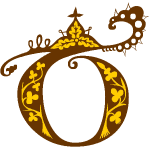Not Just Small Capitals
 penType fonts can include Decorative Capitals, which may be implemented as Stylistic Alternates, or Contextual Alternates. In my fonts, the coloured capitals are implemented as Stylistic Alternates. This Test Page shows them in use on a web page. Note that you can select the coloured glyphs in the heading. They are text, not graphics. Although browsers support OpenType Stylistic Alternates, WebPlus X8 does not, so on my test page they are inserted as Unicode characters.
penType fonts can include Decorative Capitals, which may be implemented as Stylistic Alternates, or Contextual Alternates. In my fonts, the coloured capitals are implemented as Stylistic Alternates. This Test Page shows them in use on a web page. Note that you can select the coloured glyphs in the heading. They are text, not graphics. Although browsers support OpenType Stylistic Alternates, WebPlus X8 does not, so on my test page they are inserted as Unicode characters.
Some fonts, like Palatino Linotype, which was distributed with Windows XP, have Small Capitals, but not everyone knows about them, or knows how to use them. The use of OpenType features in modern fonts is now common, and many more software applications support them — even freeware like LibreOffice.
The Serif applications, PagePlus and DrawPlus, have supported a large number of, though not all, features for many years. However, WebPlus X8 does not support them, so special characters need to be inserted from the Insert Symbol dialogue to make use of them. (See below for a test web page).
For a full list of registered features, see the Microsoft OpenType Tag Registry.
For Web Pages Too
Browsers like Firefox have supported OpenType features for years, and now most modern browsers support them. If you visit this High-Logic Test Page and enable/disable the checkboxes for OpenType features on the right, you can see the effect on the sample text.
Professional Typography
High quality fonts include glyphs designed for specific tasks. For example, although most software applications can generate superscripts from regular digits, these auto-generated glyphs may be too light in comparison to the body text. Serif PagePlus gets around this by adding a bold attribute to the small superscript digits. Thus they are about 70% of the size of regular digits, raised up, and bold. This works better in some fonts than in others.
Most fonts will have true superscripts for ¹²³, which are the correct weight and position, but only some have ⁴⁵⁶⁷⁸⁹⁰ too, and fewer still have superscript glyphs for a-z, which can be used for dates: 1st 2nd 3rd, 11th 12th 13th etc. The image below compares true superscripts for ordinals (left), with those auto-generated by PagePlus (right). Those on the right are too big, too bold, and too low.
Some OpenType features are language dependent. On the High-Logic Test Page, you can change the language code from EN (English) to NL (Netherlands) to change the fi ligature to fi.
